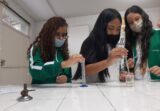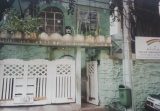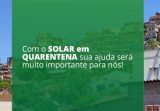Marie Curie and Pierre Curie Science Laboratory
Science is one of transforming forces of life, experimentation is part of everyday life and it is up to the teacher guide the student in the pursuit of building responses.
Solar Meninos de Luz follows pedagogical line of, increasingly, support sciences laboratory practical activities as chemical, physical and biological in its commitment to Integral Education, also life-changing.
Pedagogical Guidelines
- Constructivist conception that student builds his own knowledge, through action, placing it in the center of educational process.
- PCN – National Curriculum Parameters (1998) – orientation that “laboratory activity is not limited to glassworks and regents” and that practical activities are fundamental, ensuring effort for reflection, development and construction of ideas, knowledge, procedures and positive attitudes.
- Careful planning of work in the laboratory, from demonstrations to practical and experimental activities to achieve the goal of learning facilitating, taking into account the intended goals, available resources and previous ideas of students on the subject.
Objectives
1. About cognitive aspects
- Learning scientific concepts: development of hypotheses, testing, results organization.
- Reflection and discussion of its meaning: reaching conclusions and concepts construction.
2.About practice aspect
- Development of scientific research practical skills leading to facilitating data analysis common to communication and knowledge.
3.About feeling aspect
- Formation of positive attitudes towards science and experiments, promoting training and willingness to intervene in environment improvement.
Brief history
The best practices were always activities in the primary segments of Solar Integral School, including some Science Fairs, and less in Elementary II and High School but also performed two Science Fairs in recent years. With the unification of education from Nursery to High School – which was possible in 2015 with new new pedagogical structure, now under Solar direction (formerly run by UniverCidade) and academic staff hired by SML – there was full adoption to constructivist guidelines, holistic, education, which has facilitated the practical activities and reconstruction of knowledge by these students.
In 2004, the Science Laboratory was physically structured in the garage of house 142 of Saint Roman Street, where it runs the Early Childhood Education through partnership with Furnas, but there was great difficulty for equipment purchase.
From 2009 to 2011 it was carried out “ComCiência Project”, generating excellent experimentation activities. It was performed by graduate students at Santa Ursula University, who also donated some equipment.
In May of 2016, there was a Laboratory re-inauguration, because of important equipment donated by SCHLUMBERGER company and because of excellent Elementary II and High School teachers commitment with educational experimentation guidelines.
SCHLUMBERGER donations:
• Animal cell
• Pregnancy in 8 stages
• Double DNA Helix
• Torso Bisexual 85cm with 24 Parts with Coastal Opening
• Plant cell
• Meiosis in 10 parts
• Molecules structure with Interlocking Spheres • Mitosis into 9 parts
• Complete Kit School with 34 pieces
• Human skeleton of 85cm with stem and support
• Kit set of slides prepared for study in High School
• Birthing Simulator
• Digital Camera for Microscopy with connection to computer
• Biological Microscope monocular increased to 640X
• Cutting skin (block model Enlarged 70X) • Analytical balance – scale precision Cap.220g- 0.1mg – UniBloc technology
• 3D Printer
Some pedagogical practices carried out in the Laboratory:
1. With the material donated by SCHLUMBERGER
- Use of optical microscopes for observation of animal cells blades, vegetables and body tissues
- Skeleton assembly of human body and identification of bone structures
- Viewing and study of different stages of babies development in the womb
- Installation of cell slides of human oral mucosa for later viewing in the optical microscope
- Identification and study of the organs in the human body model donated
- Weighing and calibration reagents in analytical balance
- Installation of chemical molecules using the elements kits
- Assembly and study of double-stranded DNA in donated study model
- Observation of cellular structures and organelles of animal and plant cells in donated models
2. Other experiences (regarding science with socio environmental aspects relationship; issues of hygiene and self-care)
- Preparation of an acid rain simulator will be used to talk about oxides in the atmosphere react with water, acidifying precipitation
- Use of red cabbage to investigate rainwater samples pH (collected using PET bottles and greenhouse tissue)
- PH analysis of different food and hygiene products in daily routine
- Use of black light in cardboard box to observe contamination by touching dirty materials (stained with brand text dissolved in alcohol gel, representing microorganisms
- Production of soap and moisturizer, through topics of chemistry discipline, such as solubility, polarity and the formation of colloids
Why Marie Curie and Pierre Curie name in Sciences Laboratory?
Because of recognition of excelcitude humanitarian thought in the laboratory experiments performed by the couple, through hard work, surrounded by immense difficulties, but it brought extraordinary knowledge and Well for Humanity.
SML want Marie and Pierre Curie to be paradigms for students and educators behavior with respect to knowledge and feeling in general and experimental practice aspects.
Pierre Curie (Paris, 1859 to Paris, 1906) – Pioneer physical in crystallography study, magnetism, piezoelectricity and radioactivity.
Marie Sklodowska Curie (Varsória, 1867 to France, 1934) – Physics and chemistry, conducted studies on radioactivity, radio and polonium and its applications.
The couple became famous when receiving Nobel Prize in Physics in 1903 for research on radioactivity. Marie in 1911, returned to receive the Nobel Prize for radium and polonium discovery.
Indefatigable in finding practical contributions to science and humanity, Marie organized a mobile X-ray service, trained technicians and installed 200 x-ray stations during First World War (1914-1918) period, in France and Belgium combat zones, having served more than 1 million soldiers. She herself made applications in soldiers, driving a car. Collected the gas that emanated from the radio and sent to hospitals in various parts of the world for the treatment of cancerous tumors.
She was the first woman to receive a Nobel Prize, the first to receive it twice, the first woman to teach at Sorbonne in 1908.



